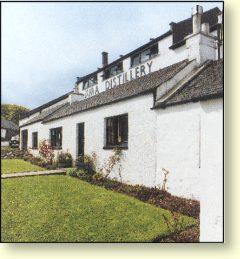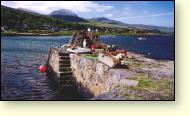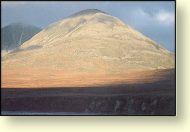
Location: Craighouse, Isle of Jura PA60 7XT
Hours: 9am - 4pm Mon - Fri; all visits by appointment
Phone: 01496-820240
|
Text from The Whisky Trails, Copyright © Gordon Brown 1993:
There is not much more to Craighouse in the south-east of the island of Jura than the hotel and the distillery. It is a delightful little harbour with tufted, rocky islets scattered about Small Isles Bay and looks pretty as a picture when the water reflects moored yachts and the bright blue sky of a summer’s day. The Paps rise in a cluster to the north behind the Jura Forest and palm trees – the climate is very mild – rustle in the breeze.

Craighouse has a small jetty, which today is mainly used by small pleasure craft.
|
Isle of Jura is the only distillery on the island and may well have been the only legal one; part-timers supplemented its supply prior to the 19th century. Open-air or cave-based illicit production around Craighouse is thought to have progressed to distillation in buildings in the village by 1810; certainly the local laird had a mill with kilning facilities built at Craighouse in 1775, which would have been useful for preparing malt. It was a time of expansion for Jura. Two years later, Thomas Telford completed the new road round the south of the island and there were change-houses at Feolin Ferry from Islay, Craighouse, Corran House, Lagg Ferry to Keills on the mainland and Kenuachdrach in the north.
The first post office opened at Lagg and the mail for Islay went by runner to Port Askaig and a second runner took it down to Bowmore. It was not until 1831 that William Abercrombie was listed as the distillery’s first licensee although until 1876 there was a number of operators, only two of whom lasted more than 12 months or so. In that year James Ferguson bought the business and rebuilt the distillery. The conditions of his lease from the local laird were very demanding and eventually friction and illwill prompted the Ferguson family to strip out their stills and machinery and abandon the distillery in 1901. Almost 20 years later, the Fergusons were still being pursued in court for payment of repairs the laird insisted was due. The roofs were taken off to avoid having to pay rates on the buildings and the shells remained thus until 1960, when a new distillery began to take shape thanks to two local men.
George Orwell’s landlord and the owner of the Jura estate commissioned the rebuilding of the distillery to help stimulate the local economy. Jura’s original production yielded a heavy, peaty whisky in the style of Islay just across the Sound, but when the new distillery was completed in 1963 the architect designed the whisky as well as the buildings. William Delmé-Evans aimed at the wider appeal of a lightly peated Highland malt and prescribed the tall stills needed to do the job. The distillery is now owned by the Whyte & Mackay group.
The whitewashed buildings sit pertly on the rise from the harbour, the cooperage from the original still in place at the edge of the roadway. The Jura Hotel opposite in an earlier guise was one of Jura’s change-houses going back to 1742 and before; the lounge bar today used to be a thatched ‘room and kitchen’. The view to the Small Isles and beyond is unimpeded.
The 1963 pair of stills was augmented by a second pair in 1978, all four being larger than most – a circumstance that contributes to the lightness of the whisky. In the same year building materials were transported by helicopter up to the water source, Market Loch, to construct a dam. The distillery has two separate water-systems: that direct from the loch is used for whisky making, and the ‘town’ water, which is sometimes chlorine-fragrant, for everything else. The spirit-receiver was made in the distinctly non-whisky-making town of Jarnac, at the heart of France’s Cognac country!
The Whisky
Text from The Whisky Trails, Copyright © Gordon Brown 1993:
As touched on above, up to the turn of the century the whisky made at Jura was big and peaty like those of neighbouring Islay, but when the distillery was reborn in 1963, the stills were designed to produce the lighter, distinctly Highland-style of whisky now associated with the island name. Its lightness shows in its silky gentleness, but it still has excellent presence with subtly peaty flavour, mellowness and balance. It is bottled at 10 years and at two strengths, 40% and 43% vol. Bottlings from individual casks through the independents are rare but a 1972 is available from one of the societies and Jura also produces its own special edition, the Stillman’s Dram, which is currently a 26-year-old.
Source of water
Market Loch
Of interest
Text from The Whisky Trails, Copyright © Gordon Brown 1993:

The Paps of Jura rise steeply from the horizon, and are the site of an annual Fell Race each May, sponsored by the distillery.Left: Inverary Castle houses a splendid arms collection and a combined operations warfare museum.
|
• At Craighouse the 1775 mill stands opposite the distillery. It pre-dates even the earliest whisky-making buildings on the site but still has much of its machinery intact.
• At Ardmenish are the remains of another mill, and at Torran Dubha, near Ardlussa, the ruin of a kiln, both of which were associated with illicit distilling.
• At Daimh-Sgeir, south of Feolin, is the grave of Jura’s very own highwaywoman who used to attack the mail-carriers from Islay. In the summary justice of the day, she is said to have been ‘disposed of’ by a local man in return for the gift of a farm. By the bridge near her grave is a gate-post from one of the numerous sets of gates that had to be negotiated in travelling on the Long Road.
• At Barnhill, near the northern end of the Long Road, George Orwell wrote his novel 1984 in the cottage there. It was completed in 1948 and he simply reversed the last two digits of the year for the book’s title. Orwell liked a drink but preferred Lamb’s Navy rum to whisky. It is not generally realised that the author had sold up in London and gone to live permanently on Jura. He died in 1950.
• The Gulf of Corryvreckan lies off the north coast between Jura and Scarba. The famous whirlpool is classified as un-navigable by the Royal Navy and is most spectacular between flood and half-flood tide. George Orwell was briefly marooned on the Eilean Mor islet when he sailed into the race and his boat fell apart; had it not been during a relatively quiescent phase, there might have been no such book as 1984in the body of English literature today.

Inverary Castle houses a splendid arms collection and a combined operations warfare museum.
|
• Beside Corran House, one of the old change-houses, lies the island emergency airstrip which is maintained for the benefit of the island by Lord Astor, owner of one of the six estates into which Jura is divided.